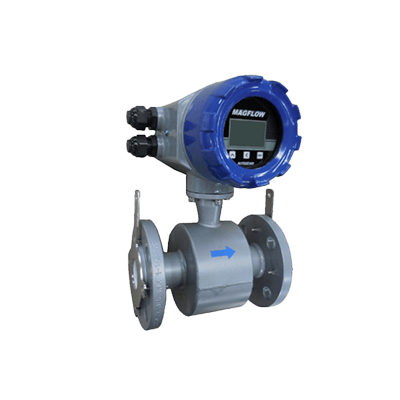What Is an Electromagnetic Flow Meter?

Electromagnetic flow meter is a device that utilizes the principles of electromagnetic induction to measure fluid flow rates.
Electromagnetic flow meters are characterized by the absence of moving parts and the absence of pressure drop in the measurement process. However, due to their operating principle, electromagnetic flow meters are limited to measuring conductive liquids and cannot measure insulating fluids like oils or gases.
When used with conductive liquids, these meters offer precise measurements unaffected by factors such as temperature, pressure, liquid density, viscosity, or conductivity. They are also capable of measuring the flow rates of slurries and corrosive chemicals containing suspended particles.
Applications of Electromagnetic Flow Meters
Electromagnetic flow meters find applications in various industries due to their ability to measure flow rates in challenging conditions. Some of the common applications include:
- Fluids containing solids, such as sand-water mixtures in civil engineering projects
- High-viscosity fluids like cement milk and mortar
- Acidic liquids, including sulfuric acid and hydrochloric acid, in chemical plants
- Basic liquids such as caustic soda used in scrubbers
- Pulp liquids and bleaching agents in the paper industry
- Beverages like fruit juice and wine in the food industry
- Pharmaceuticals and blood plasma in the medical industry
As mentioned, electromagnetic flowmeters are versatile instruments used across a wide range of fields.
Principles of Electromagnetic Flow Meters
Electromagnetic flow meters operate based on Faraday’s Law of Electromagnetic Induction, which involves the generation of voltage in a conductor moving through a magnetic field.
This phenomenon occurs when a conductive object moves within a magnetic field, generating a voltage proportional to its speed. Electromagnetic flow meters convert this voltage into flow rate data by detecting it.
A typical electromagnetic flowmeter consists of a measuring tube through which the liquid flows, an exciting coil that generates a magnetic field, and a circuit that measures the voltage induced by electromagnetic induction.
When a magnetic field is created perpendicular to the measuring tube, the conductive liquid flowing through the tube intersects the magnetic field perpendicularly, resulting in the generation of a voltage perpendicular to both the measuring tube and the magnetic field. This voltage can be used to determine the liquid flow rate.
How to Select Electromagnetic Flow Meters
The choice of an electromagnetic flow meter depends on the properties of the fluid to be measured and the installation conditions. Here are some key considerations:
1. Separate Type or Integrated Type
Select between a detector/transducer integrated type or a separate type based on the installation location.
2. Measuring Tube
Choose the measuring tube material that matches the type of liquid to be measured. Options typically include rubber and PFA lining materials.
3. Connection Method
Select the appropriate piping connection method, such as wafer or flange, based on ease of installation and removal. Note that ceramic measuring tubes are typically compatible only with wafer connections.
Additionally, choose the bore size of the measuring tube to match the connecting piping.
4. Electrode and Ground Ring Materials
Select electrode and grounding ring materials that are compatible with the fluid being measured to prevent corrosion. Materials like SUS316L are commonly used for general applications, while other materials like hastelloy, tantalum, or platinum iridium may be suitable for specific corrosive fluids.
5. Communication Method
Determine the communication method for the electromagnetic flow meter. Options may include 4-20 mA DC current analog transmission, HART communication, or other proprietary communication methods. Choose the method that aligns with your maintenance and data collection requirements.